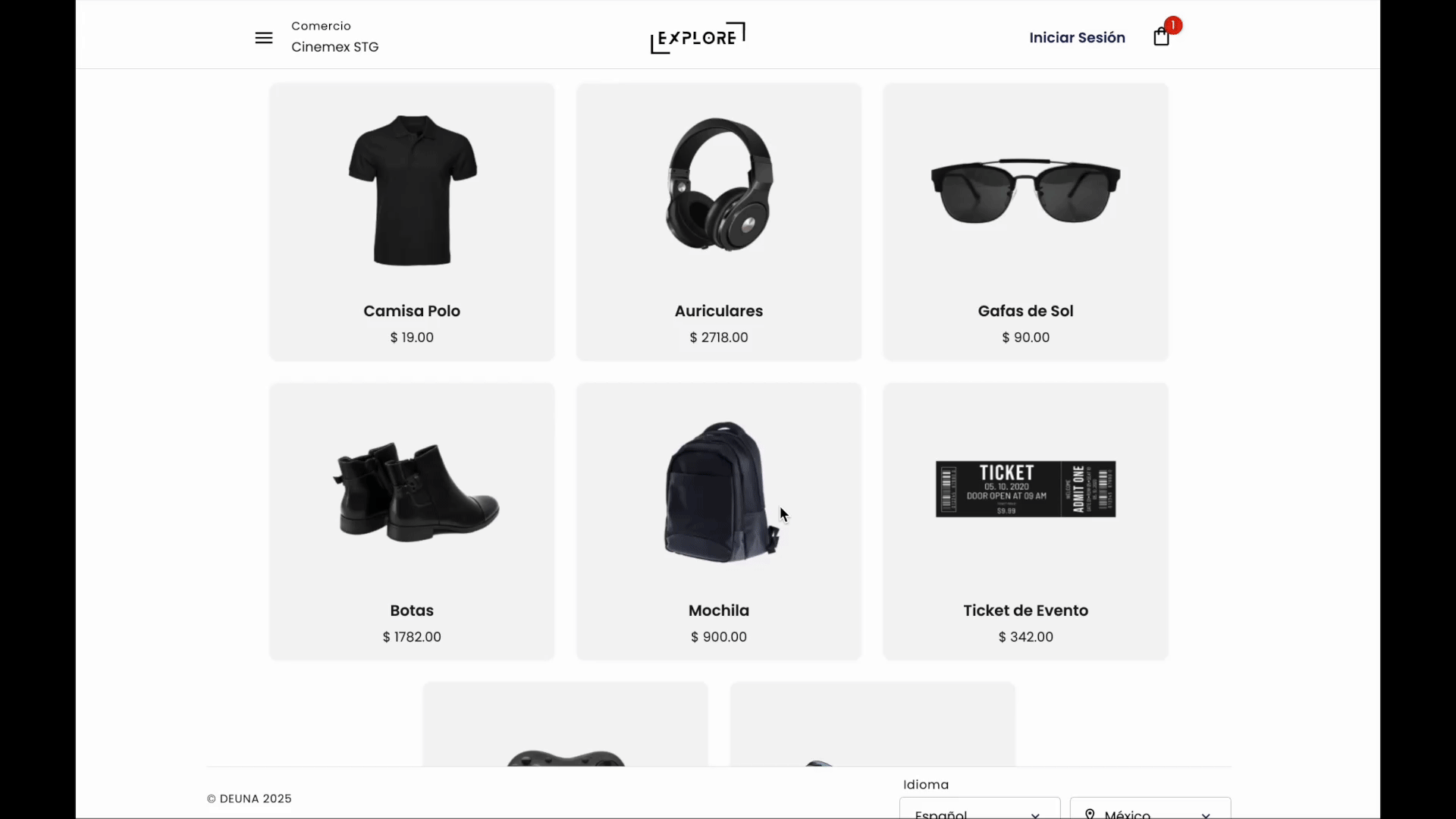Card Vault
This page documents details for saving cards in the DEUNA Payments solution in your application.
Choose your integration
Store and tokenize payment credentials with Payment's Card Vault.
Integrate the Vault into your payment solution through the following options:
Vault via SDK (recommended)
We recommend integrating the Payment Vault through our SDKs, as they offer a more optimized experience and simplify communication between applications and web pages.
In web environments, the widget can be opened in a target HTML element or displayed as a modal.
In web environments, the widget can be opened in a target HTML element or displayed as a modal.
Choose your SDK platform:
Features
The SDK exposes several callbacks that allow the merchant to react dynamically to important events within the payment flow, such as:
- When the user closes the widget.
- When a card or payment credential is successfully tokenized.
- When a tokenization attempt fails.
These features allow the merchant to customize the user experience and adapt it according to the needs of each transaction.
Vault via URL / iFrame
You can render the Payment Widget inside an Iframe or in a full tab as a redirect, in case you can't use the SDKs.
To integrate Payment Vault via URL or iFrame, refer to Embedded Vault.
Additional information
Learn more about Payment Vault integration:
- Verifying event type and card brand: The Vault recognizes card brands from event metadata.
- Discount applied if the card is Mastercard by the merchant: If the card is Mastercard, a 20% discount is applied to the current shopping cart. This action is performed entirely by your app.
- Order Update: After applying a discount, your application is responsible for updating the order using the DEUNA Update Order endpoint.
- Notification to the widget to update the order and installments: Changes in the status of an order are communicated using the method postMessage.
- The
postMessagemethod sends a message to the widget indicating what steps to follow depending on the business logic. - Include a
refetchOrderobject with type with adatavalue equal tonull.
- The
- Display a promotional tag: In addition to updating the order and payment amounts, you can apply custom CSS styling to the widget using the getCustomCSS(cardBrand) function.
Process a payment with a card_id or payment credential
card_id or payment credentialWhen a payment process is initiated in the backend of your application, you must configure the payment with a card_id to complete the purchas
You must integrate the endpoints of Payments to obtain thecard_id.
This process requires specific requests to the Payments API endpoint to complete the transaction.
Example curl request
const requestBody = {
payer_info: {
email: "[email protected]"
},
payment_source: {
method_type: "credit_card",
card_info: {
card_id: "8d369b6e-113a-4640-9e63-dc29957fc86aza",
installment: {
plan_option_id: "<uuid que se retorna en el postMessage 'onInstallmentSelected'>"
}
}
},
// ... Resto del body
};
fetch('https://api.sandbox.deuna.io/v2/merchants/orders/purchase', {
method: 'POST',
headers: {
'x-api-key': '<YOUR_PRIVATE_API_KEY>',
'Content-Type': 'application/json'
},
body: JSON.stringify(requestBody)
})
.then(response => response.json())
.then(data => console.log(data))
.catch(error => console.error('Error:', error));curl --location 'https://api.sandbox.deuna.io/v2/merchants/orders/purchase' \
--header 'x-api-key: YOUR_PRIVATE_API_KEY' \
--header 'Content-Type: application/json' \
--data-raw '{
"payer_info": {
"email": "[email protected]"
},
"payment_source": {
"method_type": "credit_card",
"card_info": {
"card_id": "8d369b6e-113a-4640-9e63-dc29957fc86aza"
}
},
"order": {
"order_id": "testapi-0003",
"currency": "MXN",
"items": [
{
"id": "216",
"name": "10 Cellphones",
"description": "",
"options": "string option",
"total_amount": {
"original_amount": 2000,
"amount": 2000,
"currency": "MXN",
"currency_symbol": "$"
},
"unit_price": {
"amount": 200,
"currency": "MXN",
"currency_symbol": "$"
},
"tax_amount": {
"amount": 0,
"currency": "MXN",
"currency_symbol": "$"
},
"quantity": 1,
"uom": "string",
"upc": "string",
"sku": "",
"isbn": "",
"brand": "",
"manufacturer": "",
"category": "",
"color": "",
"size": "",
"weight": {
"amount": 0,
"unit": "kg"
},
"image_url": "https://images-staging.getduna.com/95463fb5-6279-4ec3-8ff9-fe07aacd2142/db5b698c57654116_domicilio_216_750x750_1662162887.png?d=200x200&format=webp",
"details_url": "",
"type": "physcal",
"taxable": true
}
],
"sub_total": 2000,
"total_amount": 2000,
"store_code": "all",
"billing_address": {
"address1": "presa angostura 36PH",
"address2": "",
"address_type": "home",
"city": "CDMX",
"country_code": "MX",
"email": "[email protected]",
"first_name": "efren",
"identity_document": "162915134",
"is_default": true,
"last_name": "garcia",
"phone": "+525222222222",
"state_code": "MX",
"state_name": "miguel hidalgo",
"zipcode": "11500"
}
}
}'$curl = curl_init();
$requestBody = json_encode(array(
"payer_info" => array(
"email" => "[email protected]"
),
"payment_source" => array(
"method_type" => "credit_card",
"card_info" => array(
"card_id" => "8d369b6e-113a-4640-9e63-dc29957fc86aza"
)
),
// Aquí puedes continuar añadiendo el resto del cuerpo de la solicitud
"order" => array(
"order_id" => "testapi-0003",
"currency" => "MXN",
"items" => array(
// Aquí van los detalles de los items
),
// Continúa con el resto de los detalles del pedido
)
));
curl_setopt_array($curl, array(
CURLOPT_URL => "https://api.sandbox.deuna.io/v2/merchants/orders/purchase",
CURLOPT_RETURNTRANSFER => true,
CURLOPT_ENCODING => "",
CURLOPT_MAXREDIRS => 10,
CURLOPT_TIMEOUT => 30,
CURLOPT_HTTP_VERSION => CURL_HTTP_VERSION_1_1,
CURLOPT_CUSTOMREQUEST => "POST",
CURLOPT_POSTFIELDS => $requestBody, // Aquí se utiliza la variable
CURLOPT_HTTPHEADER => array(
"x-api-key: YOUR_PRIVATE_API_KEY", // Asegúrate de reemplazar con tu API key real
"Content-Type: application/json"
),
));
$response = curl_exec($curl);
$err = curl_error($curl);
curl_close($curl);
if ($err) {
echo "cURL Error #:" . $err;
} else {
echo $response;
}require 'uri'
require 'net/http'
require 'json'
url = URI("https://api.sandbox.deuna.io/v2/merchants/orders/purchase")
http = Net::HTTP.new(url.host, url.port)
http.use_ssl = true
request_body = {
payer_info: {
email: "[email protected]"
},
payment_source: {
method_type: "credit_card",
card_info: {
card_id: "8d369b6e-113a-4640-9e63-dc29957fc86aza"
}
}
# ... Agrega aquí el resto del cuerpo de la solicitud
}.to_json
request = Net::HTTP::Post.new(url)
request["x-api-key"] = "YOUR_PRIVATE_API_KEY" # Reemplaza con tu API key
request["Content-Type"] = "application/json"
request.body = request_body
response = http.request(request)
puts response.read_bodyimport java.net.URI;
import java.net.http.HttpClient;
import java.net.http.HttpRequest;
import java.net.http.HttpResponse;
import org.json.JSONObject;
public class Main {
public static void main(String[] args) {
HttpClient client = HttpClient.newHttpClient();
JSONObject requestBody = new JSONObject()
.put("payer_info", new JSONObject().put("email", "[email protected]"))
.put("payment_source", new JSONObject()
.put("method_type", "credit_card")
.put("card_info", new JSONObject().put("card_id", "8d369b6e-113a-4640-9e63-dc29957fc86aza")))
// ... Agrega aquí el resto del cuerpo de la solicitud
HttpRequest request = HttpRequest.newBuilder()
.uri(URI.create("https://api.sandbox.deuna.io/v2/merchants/orders/purchase"))
.header("x-api-key", "YOUR_PRIVATE_API_KEY") // Reemplaza con tu API key
.header("Content-Type", "application/json")
.POST(HttpRequest.BodyPublishers.ofString(requestBody.toString()))
.build();
client.sendAsync(request, HttpResponse.BodyHandlers.ofString())
.thenApply(HttpResponse::body)
.thenAccept(System.out::println)
.join();
}
}
To review the endpoint in detail, refer to V2 Purchase
Demo
After integrating the Payment Vault, the experience is similar to the following demo::

Updated 3 months ago